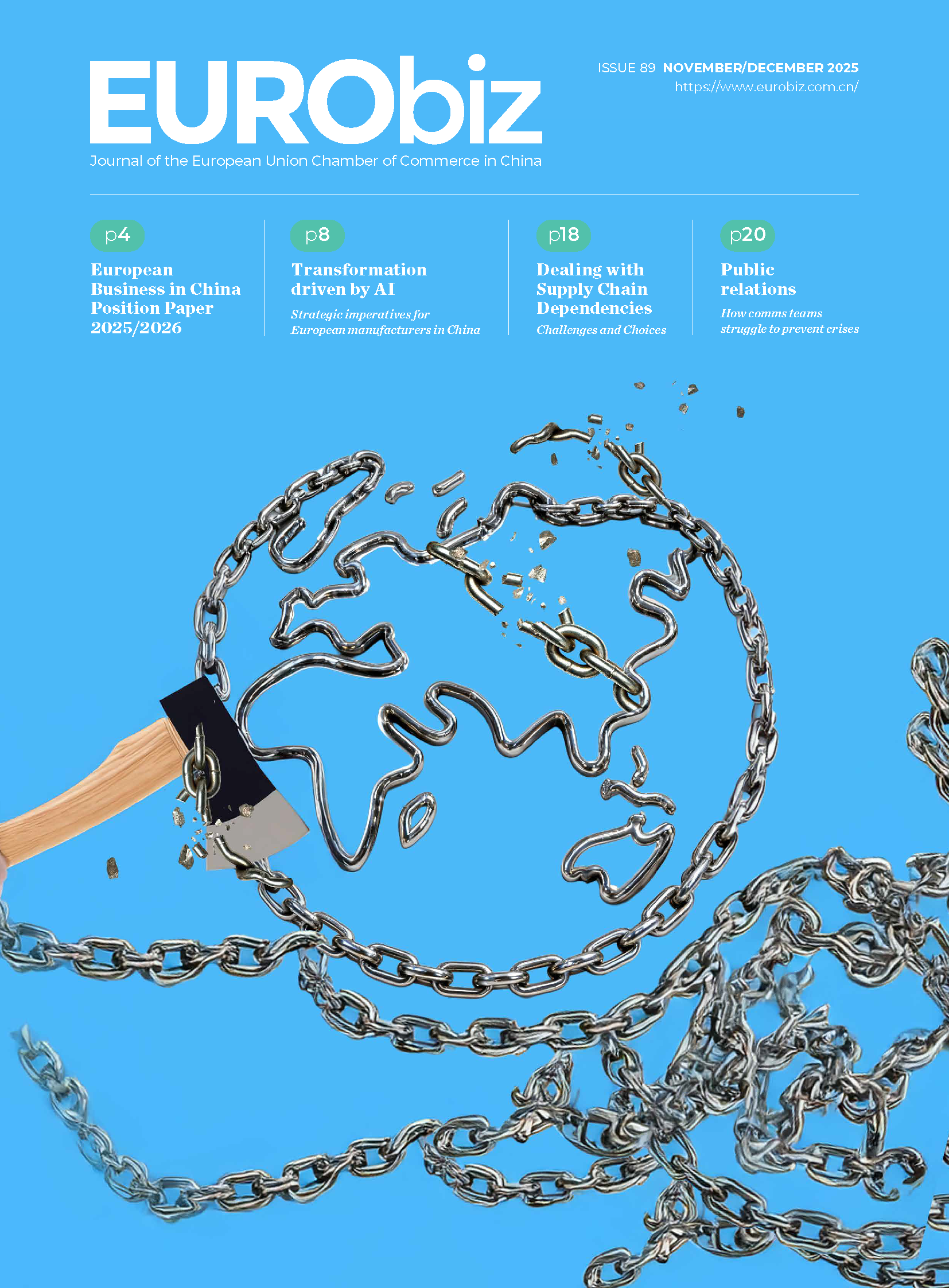
Adaptability and strategic foresight are key to survival
In 2015, Made in China 2025 (MIC2025) was unveiled. Theambitious industrial policy aimed to transform China into a global leader in advanced manufacturing and technological innovation. Designed to reduce dependence on foreign technology and elevate domestic industries up the value chain, the initiative targets 10 strategic sectors, including robotics, artificial intelligence (AI), aerospace, green energy and semiconductors. As the plan reaches its conclusion, Fabian Blake of AMS Assembly Foshan reflects on its successes, shortcomings and evolving strategies that are reshaping the corporate investment landscape in China – particularly for European businesses navigating competitive pressures and geopolitical complexities.
MIC2025 set clear benchmarks: increasing the domestic content of core manufacturing components to 40 per cent by 2020 and 70 per cent by 2025, while boosting research and development (R&D) spending and patent filings. China has made significant strides in sectors like renewable energy and high-speed rail, where it now dominates global markets. For instance, Chinese companies supply over 60 per cent of the world’s solar panels and 70 per cent of high-speed rail infrastructure. Similarly, electric vehicle (EV) production has surged, with domestic brands like BYD capturing 22.2 per cent of global EV sales in 2024.[1]
However, progress has been uneven. Semiconductors, a cornerstone of MIC2025, remain a critical weakness. Despite state-backed investments worth United States dollar 150 billion since 2015, domestic chipmakers supply only 16 per cent of China’s semiconductor needs, far below the 40 per cent target for 2020. United States (US) export controls on advanced chipmaking tools have exacerbated delays, forcing China to prioritise legacy chip production rather than cutting-edge designs.
Missed targets and structural challenges
While MIC2025 has accelerated automation and digitalisation—China installed 45 per cent of the world’s industrial robots in 2023—the reliance on foreign intellectual property (IP) persists. Sixty-five per cent of critical industrial software used in Chinese manufacturing remains imported, undermining self-sufficiency goals. Additionally, overcapacity in sectors like steel and EVs has triggered anti-subsidy investigations by the European Union (EU), reflecting tensions between MIC2025’s state-driven model and global trade norms.
The policy’s opaque subsidies and preferential treatment for domestic firms have also deterred foreign investors. European businesses report increasing hurdles in accessing China’s market unless they agree to joint ventures (JVs) or technology transfers.
Investment shifts: opportunities and risks
MIC2025 has reconfigured China’s investment ecosystem. In 2023, foreign direct investment (FDI) into high-tech manufacturing rose 22 per cent year-on-year, driven by tax breaks and streamlined approvals for greenfield projects. European automakers like Volkswagen (VW) and BMW are doubling down on EV partnerships to leverage China’s supply chain efficiencies, with VW investing euro 2.5 billion in a Hefei R&D centre focussed on autonomous driving.[2]
However, there are clouds on the horizon. Overcapacity in renewables and EVs has squeezed profit margins, with Chinese solar panel prices dropping 40 per cent since 2022. Meanwhile, the EU’s Carbon Border Adjustment Mechanism (CBAM) and ‘de-risking’ strategy are prompting firms to diversify supply chains away from China. MIC2025’s focus on import substitution could further alienate foreign investors, particularly in sectors where China’s innovation lags.
European businesses: adaptation and resistance
European companies in China face a dual reality. While MIC2025 has created opportunities in smart infrastructure and green tech, it has also intensified competition. Siemens and ABB now compete with state-subsidised rivals like CRRC and Huawei when bidding for smart grid contracts, often at lower margins. Conversely, Danish wind turbine maker Vestas has thrived by localising production, securing 15 per cent of China’s offshore wind market in 2023.
The policy’s emphasis on self-reliance has also spurred regulatory crackdowns, with the recent raids on Capgemini and Bain & Company underscoring rising compliance risks.
The road ahead: strategic considerations
With MIC2025 now in its final stretch, corporate executives must weigh several factors:
- Sectoral prioritisation: Invest in areas where China still seeks foreign expertise (e.g., advanced materials, biotech) while avoiding oversaturated markets like EVs.
- Local partnerships: JVs remain a double-edged sword but are often essential for market access. Structuring agreements to safeguard IP is critical.
- Geopolitical agility: Diversify supply chains and prepare for retaliatory or defensive measures as Western governments counter Chinese subsidies.
It is predicted that FDI growth will slow to around four per cent annually through 2025, down from eight per cent pre-pandemic. However, China’s vast consumer base and innovation clusters in cities like Shenzhen will continue to attract ventures that are aligned with MIC2025’s goals.
Conclusion
MIC2025 has undeniably reshaped global manufacturing dynamics, offering both promise and peril for foreign investors. For European businesses, success hinges on balancing collaboration with caution. Companies need to leverage China’s industrial ambitions while mitigating the risks of overexposure.
European firms can partner with Chinese companies in areas where China still lacks expertise, such as specialised materials or precision manufacturing equipment. For example, German chemical giant BASF has collaborated with Chinese EV battery manufacturers to co-develop advanced cathode materials but retains ownership of proprietary formulas through tightly negotiated joint venture agreements. This allows access to China’s booming EV market without surrendering core intellectual property.
In order to sidestep overcapacity and geopolitical risks, some companies, like Siemens Energy, have localised production of wind turbine components in China exclusively for domestic buyers, while sourcing critical parts (e.g., high-performance bearings) from Europe. Simultaneously, they have shifted export-orientated manufacturing to Southeast Asia to avoid EU tariffs on Chinese clean-tech imports. This dual approach balances market access with de-risking.
By combining innovation-driven partnerships with agile supply chains, European businesses can navigate MIC2025’s dual realities – allowing them to compete in China’s high-tech market while insulating themselves from its systemic risks. As the policy evolves under global scrutiny, adaptability and strategic foresight will define winners in the next phase of China’s economic ascent.
Fabian Blake is the managing director of AMS Assembly Foshan. He has lived and worked in China since 2008, accumulating close to 17 years of valuable experience in Asia.
AMS Assembly Foshan is a Dutch-owned company that operates in the Pearl River Delta and has provided manufacturing services in South China since 2003. The company currently boasts a workforce of 80 employees, with 73 staff members based in AMS facilities located in Foshan and Shenzhen. The company is actively involved in the development, manufacturing and assembly of hardware devices, primarily serving customers in Europe.
[1] What are the global EV market’s most successful brands?, AUTOVISTA24, 17th February 2025, viewed 18th April 2025, <https://autovista24.autovistagroup.com/news/what-are-the-global-ev-markets-most-successful-brands/#:~:text=BYD’s%20global%20EV%20success,points%20(pp)%20from%202023.>
[2] Volkswagen invests 2.5 billion euros to expand innovation hub in China, China Daily, 12th April 2024, viewed 15th April 2025, <https://www.chinadaily.com.cn/a/202404/12/WS6618d113a31082fc043c1a6e.html>


Recent Comments